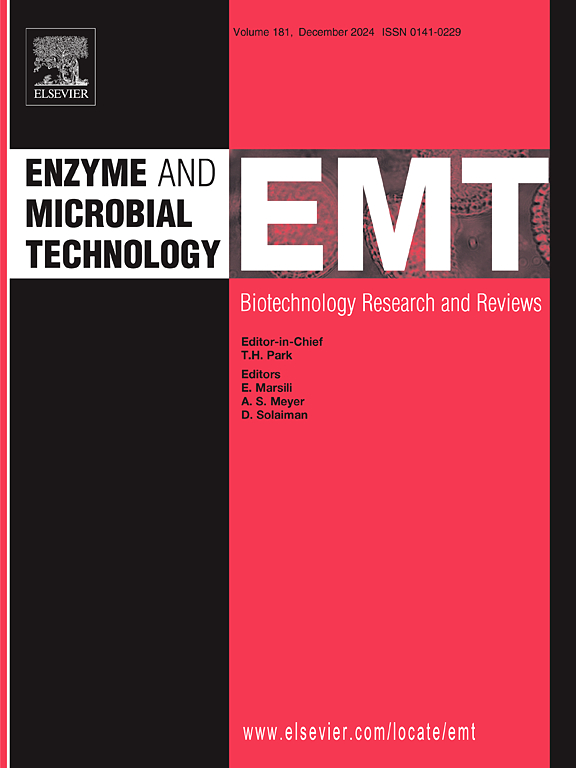利用分裂式GFP系统显示CAL-B在大肠杆菌中的细胞表面
IF 3.7
3区 生物学
Q2 BIOTECHNOLOGY & APPLIED MICROBIOLOGY
引用次数: 0
摘要
细菌表面展示系统使蛋白质固定在外膜上的应用,如肽库筛选,生物传感和生物吸附。然而,大蛋白质的显示效率仍然有限,主要是由于在跨膜转运大体积多肽的挑战。为了解决这个问题,我们评估了一种基于绿色荧光蛋白(GFP)的分裂策略。该方法使用两个非荧光GFP片段gfp11和gfp1 - 10,它们在共定位时重新组装成荧光复合物。在本研究中,小片段GFP (GFP11)与脂蛋白外膜蛋白A (lp - ompa)融合以促进膜锚定,而大片段GFP (GFP1-10)与南极念珠菌脂肪酶B (CAL-B)融合。CAL-B-GFP1-10融合蛋白单独表达,然后与显示lp - ompa - gfp11的细胞孵育,促进细胞表面的潜在重组。荧光的恢复是表面成功定位的间接指标。还进行了酶分析,比较通过分裂GFP系统显示的CAL-B的活性与传统的直接融合到lp - ompa。结果表明,分裂GFP方法可以增强表面显示并保持酶功能,为显示大型或结构复杂的蛋白质提供了有希望的替代方法。虽然需要进一步优化,但这些发现支持了分裂gfp辅助策略在扩大细菌表面显示应用范围方面的潜力。本文章由计算机程序翻译,如有差异,请以英文原文为准。
Cell surface display of CAL-B in Escherichia coli using the split GFP system
Bacterial surface display systems enable the immobilization of proteins on the outer membrane for applications such as peptide library screening, biosensing, and bioadsorption. However, the display efficiency of large proteins remains limited, primarily due to challenges in translocating bulky polypeptides across the membrane. To address this, a split Green Fluorescent Protein (split GFP)-based strategy was evaluated. This method employs two non-fluorescent GFP fragments—GFP11 and GFP1–10—that reassemble into a fluorescent complex when co-localized. In this study, the small GFP fragment (GFP11) was genetically fused to Lipoprotein-Outer Membrane Protein A (Lpp-OmpA) to promote membrane anchoring, while the large GFP fragment (GFP1–10) was fused to Candida antarctica lipase B (CAL-B). The CAL-B-GFP1–10 fusion protein was expressed separately and then incubated with cells displaying Lpp-OmpA-GFP11, facilitating potential reassembly on the cell surface. Restoration of fluorescence served as an indirect indicator of successful surface localization. Enzymatic assays were also performed to compare the activity of CAL-B displayed via the split GFP system versus conventional direct fusion to Lpp-OmpA. The results demonstrated that the split GFP approach can enhance surface display and preserve enzymatic function, offering a promising alternative for displaying large or structurally complex proteins. While further optimization is needed, these findings support the potential of split GFP-assisted strategies in expanding the scope of bacterial surface display applications.
求助全文
通过发布文献求助,成功后即可免费获取论文全文。
去求助
来源期刊

Enzyme and Microbial Technology
生物-生物工程与应用微生物
CiteScore
7.60
自引率
5.90%
发文量
142
审稿时长
38 days
期刊介绍:
Enzyme and Microbial Technology is an international, peer-reviewed journal publishing original research and reviews, of biotechnological significance and novelty, on basic and applied aspects of the science and technology of processes involving the use of enzymes, micro-organisms, animal cells and plant cells.
We especially encourage submissions on:
Biocatalysis and the use of Directed Evolution in Synthetic Biology and Biotechnology
Biotechnological Production of New Bioactive Molecules, Biomaterials, Biopharmaceuticals, and Biofuels
New Imaging Techniques and Biosensors, especially as applicable to Healthcare and Systems Biology
New Biotechnological Approaches in Genomics, Proteomics and Metabolomics
Metabolic Engineering, Biomolecular Engineering and Nanobiotechnology
Manuscripts which report isolation, purification, immobilization or utilization of organisms or enzymes which are already well-described in the literature are not suitable for publication in EMT, unless their primary purpose is to report significant new findings or approaches which are of broad biotechnological importance. Similarly, manuscripts which report optimization studies on well-established processes are inappropriate. EMT does not accept papers dealing with mathematical modeling unless they report significant, new experimental data.
 求助内容:
求助内容: 应助结果提醒方式:
应助结果提醒方式:


